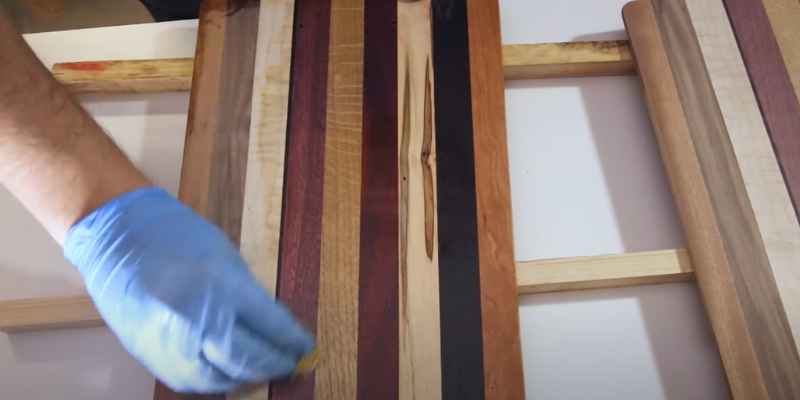Tung oil can darken wood as it penetrates the surface, enhancing the natural color and grain pattern. Tung oil is a popular choice for finishing wood due to its ability to provide a rich, warm tone while also offering protection against moisture and wear.
When applied to wood, tung oil seeps into the pores, highlighting the natural beauty of the grain and causing the wood to darken. This darkening effect is especially pronounced on lighter-colored woods, such as pine or maple. However, tung oil may not darken wood as much on already dark or dense woods, such as walnut or mahogany.
It is important to note that the degree of darkening can vary depending on the number of coats applied and the specific type of tung oil used.
What Is Tung Oil?
Are you wondering what exactly Tung Oil is and how it affects the appearance of wood? In this section, we will delve into the origins and composition of Tung Oil, as well as its common uses. Let’s explore the fascinating world of this natural finishing product.
Origin And Composition
Tung Oil is derived from the seeds of the Tung tree, scientifically known as Aleurites fordii. This tree is native to China and other parts of East Asia. The Tung Oil that is commonly used as a finish on wood surfaces is obtained by cold-pressing the nuts of the Tung tree.
When it comes to the composition of Tung Oil, it is primarily made up of triglycerides and fatty acids. This unique combination gives it excellent penetrating properties, making it a popular choice for enhancing and protecting wood surfaces.
Common Uses
Tung Oil has a long history of use in traditional Chinese medicine, but it is most widely recognized for its role as a wood finish. Its natural composition and ability to penetrate the wood fibers make it a preferred choice among woodworkers and craftsmen.
Here are some common uses of Tung Oil:
- Wood finishing: Tung Oil is often used as a finishing product for wooden furniture, floors, and even musical instruments. It enhances the natural beauty of the wood, providing a warm and rich appearance.
- Waterproofing: Due to its ability to penetrate deeply into the wood, Tung Oil creates a waterproof barrier, making it an ideal choice for outdoor wood projects like decks and fences.
- Protective coating: Tung Oil forms a protective layer on the wood surface, shielding it from moisture, stains, and general wear and tear. It also helps to minimize cracking and warping, prolonging the lifespan of the wood.
Additionally, Tung Oil is often used in combination with other oils or solvents to create customized finishes tailored to specific needs and preferences.

The Myth Of Tung Oil Darkening Wood
For many woodworking enthusiasts, the idea that tung oil darkens wood is a widely accepted belief that has been passed down through generations. But is it really true? Let’s delve into the origins of this myth and separate fact from fiction.
Understanding The Science Behind Wood Darkening
To truly understand whether tung oil darkens wood, we need to grasp the underlying science behind wood darkening itself. The primary cause of wood darkening is exposure to light and oxygen, causing a process known as oxidation. This natural reaction alters the wood’s chemical structure and results in a darker appearance over time.
Contrary to popular belief, tung oil does not contribute significantly to wood darkening. In fact, tung oil has a natural amber color, which may initially enhance the wood’s hue but does not cause a darkening effect.
Factors That Influence Wood Darkening
When it comes to woodworking, understanding the factors that influence wood darkening is essential, especially if you’re considering using tung oil as a finish. While tung oil is a popular choice for enhancing the natural beauty of wood, it’s important to know how it may affect the color of the wood over time. Several factors can influence how tung oil will darken wood, including the wood species, exposure to sunlight, and application technique.
Wood Species
The wood species plays a significant role in how tung oil darkens the wood. Some species, such as walnut and cherry, naturally have a darker hue and tend to deepen even further with the application of tung oil. Conversely, lighter woods like maple or birch may not experience the same level of darkening. It’s important to consider the inherent color of the wood species when determining how tung oil may affect its appearance.
Exposure To Sunlight
Exposure to sunlight is another critical factor in wood darkening. Sunlight can cause woods to darken naturally over time, and when combined with the application of tung oil, the effect can be more pronounced. UV rays from sunlight can accelerate the oxidation process, causing the wood to develop a deeper and richer color. So, if you plan to use tung oil on a piece of furniture or flooring that will be exposed to sunlight, expect the wood to darken more significantly.
Application Technique
The technique used to apply tung oil can also impact how the wood darkens. Applying tung oil in thin, even coats can result in a lighter and more subtle darkening effect. Conversely, if the oil is applied in thick layers or left to pool in certain areas, the darkening effect may be more intense. It’s crucial to follow the manufacturer’s instructions for proper application to achieve the desired level of color enhancement without overly darkening the wood.
Tung Oil Application Tips
When it comes to preserving and enhancing the natural beauty of wood, Tung oil is a popular choice among craftsmen and DIY enthusiasts. Not only does it provide a protective finish, but it also brings out the richness and depth of the wood grain. However, one question that often arises is, does Tung oil darken wood?
Preparing The Wood Surface
Before applying Tung oil, it is crucial to properly prepare the wood surface to ensure optimal results. Start by sanding the wood using progressively finer grit sandpaper, starting from around 120 grit and ending with 220 grit. This helps to smooth out any rough patches or imperfections and allows for better adhesion of the Tung oil.
Once the sanding is complete, it is important to remove any dust or debris from the surface. Wipe down the wood with a clean, lint-free cloth or use a tack cloth to ensure a clean surface for the Tung oil application.
Proper Application Method
The application of Tung oil plays a significant role in determining the final appearance of the wood. When applying Tung oil, it is essential to follow the proper method to achieve the desired outcome.
- Apply thin coats: It is recommended to apply thin coats of Tung oil rather than thick layers. This allows for better absorption and penetration into the wood, resulting in a more even and attractive finish.
- Use a lint-free cloth or brush: When applying Tung oil, use a lint-free cloth or a natural-bristle brush to evenly distribute the oil over the wood surface. This helps to prevent streaks or uneven application.
- Allow for proper drying time: After each coat of Tung oil, allow sufficient drying time as indicated on the product label. This ensures proper curing and helps to achieve a durable and long-lasting finish.
Sealing And Maintenance
Once the Tung oil has been applied and dried, it is important to seal the wood for added protection and to maintain its appearance over time. There are several options for sealing the wood, such as using a clear varnish or wax finish. The sealing process helps to prevent water damage, stains, and general wear and tear.
To maintain the beauty of the Tung oil finish, regular maintenance is required. This includes periodically cleaning the wood with a mild cleanser and a soft cloth, avoiding harsh chemicals or abrasive cleaners that can damage the oil finish.
Additionally, it is recommended to periodically apply a fresh coat of Tung oil to rejuvenate the wood’s appearance and maintain its protective qualities. This helps to keep the wood looking vibrant and enhances its natural characteristics over time.

Alternative Finishes For Wood
Tung oil is a popular alternative finish for wood, but does it darken the wood? Find out more about the effect of tung oil on wood color and explore other alternative finishes for different aesthetic preferences.
When it comes to finishing wood, tung oil is often one of the top choices for a natural and beautiful finish. However, there are a variety of alternative finishes available that can provide different characteristics and appearances for your wood surfaces. In this article, we will compare tung oil with other popular finishes and discuss their pros and cons.
Comparing Tung Oil With Other Finishes
Before exploring the alternative finishes, it’s important to understand how tung oil compares to them. Tung oil is derived from the nut of the tung tree and is known for enhancing the natural beauty of wood, providing a warm, rich finish. It penetrates deeply into the wood, creating a strong protective layer that enhances the durability and longevity of the wood surface.
Now, let’s take a look at some alternative finishes:
Pros And Cons Of Different Finishes
1. Polyurethane:
Polyurethane is a synthetic finish that forms a hard, glossy layer on the wood’s surface. It provides excellent protection against scratches, stains, and moisture. However, it can give a plastic-like appearance, which may not suit everyone’s taste. Additionally, it requires sanding between coats and can be challenging to repair if damaged.
2. Shellac:
Shellac is a natural finish made from the secretions of the lac bug. It provides a beautiful, glossy finish with a warm amber hue. It is easy to apply and dries quickly. However, shellac is not as durable as some other finishes and can be damaged by alcohol and heat. It may require regular maintenance to preserve its appearance.
3. Varnish:
Varnish is a synthetic finish that creates a hard protective coating on the wood. It is highly durable and resistant to heat, moisture, and chemicals. Varnish provides a glossy appearance and enhances the wood’s natural color and grain. However, it can be challenging to apply evenly and may require sanding between coats for a smooth finish.
4. Lacquer:
Lacquer is a synthetic finish that forms a hard, durable layer on the wood’s surface. It dries quickly and provides a smooth, glossy finish. Lacquer is resistant to scratches, moisture, and heat. However, it requires careful application due to its volatile nature, and repairing lacquer finishes can be difficult.
5. Oil-based Polyurethane:
Similar to regular polyurethane, oil-based polyurethane provides excellent protection and durability. It has a slower drying time, which allows for easier application without leaving brush marks. However, it can take longer to cure fully and may emit strong fumes during the drying process.
Now that we have explored some alternative finishes, you can make an informed decision based on your preferences and the specific needs of your project. Remember to consider the appearance, durability, ease of application, and maintenance requirements of each finish to find the perfect choice for your wood surfaces.
Conclusion
To summarize, tung oil has a tendency to darken wood, enhancing its natural beauty while providing protection. This versatile finishing option brings out the rich tones and depth of the wood grain, making it a popular choice for furniture and other wooden surfaces.
Whether you prefer a darker, more rustic look or a lighter, more natural finish, tung oil can be tailored to your desired outcome. Experimenting with different application techniques and layers can help you achieve the perfect balance of color and protection for your project.
So go ahead and embrace the transformative power of tung oil on your next woodworking venture.


